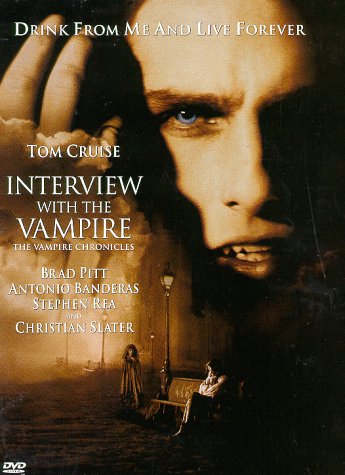Interview with the Vampire: The Vampire Chronicles

Interview with the Vampire: The Vampire Chronicles | ||
 |
Director: | Neil Jordan | Actors: | Tom Cruise (as Lestat de Lioncourt), Brad Pitt (as Louis de Pointe du Lac), Kirsten Dunst (as Claudia), Stephen Rea (as Santiago), Antonio Banderas (as Armand), Christian Slater (as Daniel Malloy), Virginia McCollam (as Whore on Waterfront), John McConnell (I) (as Gambler), Mike Seelig (as Pimp), Bellina Logan (as Tavern Girl), Thandie Newton (as Yvette), Indra Ov� (as New Orleans Whore), Helen McCrory (as 2nd Whore), Lyla Hay Owen (as Widow St. Clair), Lee Emery (II) (as Widow's Lover) | Country: | USA | Category: | Drama | Year: | 1994 |
| Description: | A vampire tells his epic life story: love, betrayal, loneliness, and hunger. | Comments: | Spoilers herein. Putting together a project like this requires attention to four elements: Situation (aka: story and mythology), Characters (usually focused on acting), Atmosphere, and Self-reference. 150 comments here deal with the first two; whether the story had drive and power (probably okay), whether the situation was readable and compelling (probably okay), and whether the actors connected (probably yes for Dunst and Pitt). So let's focus on the other two which are by far the more important, harder to deliver and incidentally overlooked in nearly all comments so far. The `atmosphere' is partly a matter of style, but more a matter of how consistent is that style and how effectively communicated. It is more than creating lush sets, instead encompasses the whole ability of the artist to transport us to another world. I'm particularly sensitive to being hypnotized by competent transporters. Didn't work here -- a matter of failure to understand the space. Everything in the environment was a thing, not an element of the environment. The other element, `selfreference' is much more interesting here, and that is because the books handle it so well. In fact it is the only thing that discriminates Anne Rice from thousands of other hacks, her cleverness with narrative. As an ordinary matter of craft, the writer often uses framing devices to establish the character of the narration. In an ordinary movie, the surrogate narrator will appear at the beginning, to settle the tone. Some clever relationship is expected between the character as narrator and as a participant in the story. And that's apparently how this starts. Another framing device, also very common, is to place a play (or equivalent) within the play. Again, some clever relationship between the small play, the larger play and often the even larger `real world' is expected. And this is done too, seemingly according to formula. (Later Lestat becomes a professional performer.) But see what has been done as a sly trick. Rice's stance is to play with the non-humanity versus humanity of the characters. These framing devices almost always expose the `within' as richer than what what we see, and what she has done is turn them on their head: the `within' in each of these cases is less, not more. This sort of narrative trick is to be expected from someone exposed to the Berkeley/San Francisco writer's club. It's not great art, but it is clever and it allows her -- in the books -- to manipulate the atmosphere. It turns irony on its head. The `story' in each case is real where we expect it to be fake. For instance, the Paris drama is presumed by the audience to be fake, but so real a trick it seems real. But the trick is that it IS real. Rice gets this right in the books. But the hapless director here has no clue at all. Cruise neither. And this is why they couldn't get the atmosphere or humor right. They are using the formulas the regular way instead of upside down. The comedy is not supposed to be in laughing at Cruise dancing with a corpse, but laughing at ourselves for not laughing at Cruise. Pitt has made a career working with just this effect, so he tunes into a channel on a radio no one else in the movie knows is there, and delivers. No one except perhaps Miss Dunst. She has little intelligence, but she seems to be a very, very good listener and it must have been Pitt talking. My gold standard right now for child performances is the few seconds of a six year old Alicia Witt in Lynch's `Dune.' That is barbed into my outer mind. Dunst here comes close in some moments: `I want some more.' But at other times seems driven by the director to be just melodramatic. |
Languages: | English | Subtitles: | Length: | 123 | Video format: | Audio format: | Resolution: | Files sizes: | 1221 |